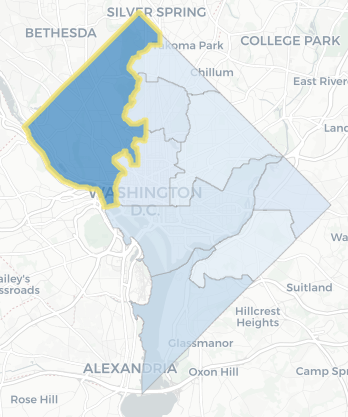FOR IMMEDIATE RELEASE
Analysis of School Enrollment Finds Few Predictable Pathways Through 12th Grade for D.C. Families
Three-quarters of all public school students living in the Wilson High School feeder pattern attend their in-boundary school, but elsewhere in D.C., a nearly equal share go out of boundary or choose charters.
WASHINGTON, D.C. April 17, 2018 – In all of the District of Columbia, a new report finds, there’s only one pocket of the city where a majority of families in public school choose their in-boundary middle or high school. This is among the findings of a report released today by the D.C. Policy Center’s Education Policy Initiative that examines the connections between neighborhood characteristics and boundary school enrollment rates among the District of Columbia’s public school students.
The report, Schools in the Neighborhood: Can Neighborhood Characteristics Explain Enrollment at In-Boundary Schools?, finds that residing within the feeder pattern for Wilson High School outweighs all other neighborhood aspects in explaining the differences in boundary participation rates across neighborhoods, beginning as early as pre-kindergarten years. At the elementary level, 79 percent of public school students who live in Wilson HS feeder neighborhoods attend their in-boundary D.C. Public Schools option, compared with 26 percent of students living in other parts of the city. Outside of the Wilson pattern, there are only four other elementary schools in the District that attract a majority of in-boundary families. No middle or high school outside the Wilson HS feeder pattern exceeds 50 percent.
Steven Glazerman of Mathematica Policy Research, who was an adviser on the report, said, “This study tells the story of D.C. being a ‘District of Choosers,’ but with two different systems of school choice – one where families buy or rent homes in fancy neighborhoods and attend in-boundary schools, and the rest of the city, where families shop around, choose off the menu, and apply through the lottery.”
Single-family homes within the Wilson HS boundary average an estimated value of $547 per square foot, 38 percent higher than the citywide average of $396 per square foot. In Congress Heights, where median housing values are among the lowest in the city at $198 per square foot, only 17 percent of families choose an in-boundary DCPS school.
The report’s findings suggest that the influence of Wilson HS extends beyond just the academic performance of the highly regarded school or the performance of its feeders. While the analysis did not focus on school-level characteristics in-depth, location in the Wilson HS boundary was still a significant factor after controlling for academic performance. As popular as the Wilson feeder pattern is within its feeder school neighborhoods, 44 percent of families there opt out of public school options entirely, choosing private schools over DCPS or charter schools. Citywide, 16 percent of students are in private schools.
Chelsea Coffin, the director of the D.C. Policy Center’s Education Policy Initiative, authored the report. “Many studies focus on school quality to explain school choice, but beyond school quality, school location and demographics also influence enrollment decisions,” Coffin said. “This report provides a new neighborhood-level perspective to describe enrollment patterns in the District, and creates a dataset of school boundary characteristics that others can use for their own analyses.”
Neighborhood demographics are associated with school enrollment patterns, as has been shown in previous research—for instance, boundary participation rates were lowest in neighborhoods with large African American populations, controlling for other factors (including location in the Wilson HS feeder pattern). But the implications of these other characteristics are very small when compared to location in the Wilson HS boundary. Proximity also makes a difference for enrollment at public charter schools: families who live close to more public charter schools are more likely to enroll in them.
Another report adviser Jon Valant, a fellow in the Brown Center of Education Policy at the Brookings Institution, said the study provides a fresh look at school enrollment patterns in D.C. “This report provides new insights about how D.C. families are choosing schools for their children—and what that says about equity and opportunity in D.C.,” Valant said.
The findings in this study are based on an analysis of demographic, economic, and other characteristics of 109 neighborhoods around each DCPS in-boundary school and their relation to patterns of enrollment at in-boundary schools, out-of-boundary schools, and public charter schools.
“Schools in the Neighborhood” is the first installment in the D.C. Policy Center’s education research series “Changing Schools in a Growing City.” Upcoming reports will explore how D.C.’s public schools retain cohorts of students, the relationship between diversity and demand for schools, and how housing and schools are connected.
Read more:
To keep up with the “Changing Schools in a Growing City” series, sign up for emails from D.C. Policy Center.
###
Contact
Chelsea Coffin
Director, Education Policy Initiative, D.C. Policy Center
202-223-4560
